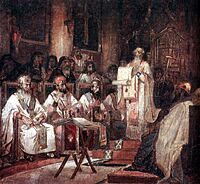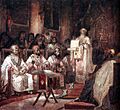Second Council of Constantinople facts for kids
Quick facts for kids Second Council of Constantinople |
|
|---|---|

Artistic rendition of Second Council of Constantinople by Vasily Surikov
|
|
| Date | 553 |
| Accepted by |
|
|
Previous council
|
Council of Chalcedon |
|
Next council
|
Third Council of Constantinople |
| Convoked by | Emperor Justinian I |
| President | Eutychius of Constantinople |
| Attendance | 152 |
| Topics | Nestorianism Origenism |
|
Documents and statements
|
14 canons on Christology and against the Three Chapters. 15 canons condemning the teaching of Origen and Evagrius. |
| Chronological list of ecumenical councils | |
The Second Council of Constantinople was a very important meeting of church leaders. It was the fifth of the first seven "ecumenical councils." These were big meetings where bishops from all over the Christian world gathered. Both the Eastern Orthodox Church and the Catholic Church see this council as very important. Other Christian groups, like the Old Catholic Church, also recognize it.
This council happened in the year 553. It was called by the Byzantine Emperor Justinian I. The main leader of the meeting was Patriarch Eutychius of Constantinople. About 152 bishops attended, mostly from the Eastern parts of the Roman Empire. Only a few bishops from the Western parts were there.
The main goal of the council was to deal with some old arguments about Jesus. They wanted to make sure everyone agreed on how Jesus could be both fully human and fully divine. They especially focused on condemning certain writings called the "Three Chapters." These writings were seen as supporting ideas that went against the agreed-upon beliefs about Jesus.
The council also wanted to make it clear that Mary is truly the Mother of God (called Theotokos). Some people had argued she was only the mother of the human Jesus. This meeting helped to bring more peace to the church, though some disagreements continued for a long time.
What Happened at the Council?
The council was led by Patriarch Eutychius of Constantinople. He was helped by other important church leaders from the East. Pope Vigilius was invited to the council. He was living in Constantinople at the time. However, he chose not to attend the meeting. He even sent a message saying the council shouldn't start without him.
But the council went ahead anyway. They decided to condemn the "Three Chapters." These were writings by three church teachers: Theodore of Mopsuestia, Theodoret of Cyrrhus, and Ibas of Edessa. Their writings were thought to support ideas that separated Jesus's human and divine natures too much. This was a problem because the church wanted to emphasize that Jesus is one person with two natures.
Because Pope Vigilius refused to join and approve their decisions, the bishops removed his name from their official church lists. This meant they were cutting ties with him personally. After being held by the emperor for six months, Pope Vigilius finally agreed. In December 553, he condemned the Three Chapters himself. He said his earlier hesitation was because his advisors had misled him.
Impact of the Council
Even with the disagreements, the council made important contributions to Christian belief. It helped to clearly define that Jesus has two natures: human and divine. These two natures are perfectly joined in one person, Jesus Christ. This idea became a strong foundation for later Christian teachings about Jesus.
However, the council did not completely solve all the church's problems. In some parts of Western Europe, like Northern Italy, some churches disagreed with the council's decisions for a while. It took many years for everyone to accept it fully.
The emperor had hoped this council would unite different groups in the church. But some disagreements continued for centuries. New ideas, like monoenergism and monotheletism, tried to find a middle ground. These ideas suggested that Jesus had only one energy or one will. But these were also rejected by the church.
Council Records
The original records of the council, written in Greek, are now lost. But there is an old Latin version that still exists. People used to think these records were incomplete. They didn't mention the debates about another set of teachings called Origenism.
However, most experts now believe that the bishops condemned Origenism before the council officially began. This condemnation was later confirmed by Pope Vigilius. The next big church council, the Third Council of Constantinople, also agreed with the decisions of this Fifth Council. It specifically mentioned condemning the teachings of Origen.
There is also a record of the council in the Syriac language. One of the council's acts also included condemning those who rejected the idea of the Perpetual Virginity of Mary.
Images for kids
-
Artistic rendition of Second Council of Constantinople by Vasily Surikov


